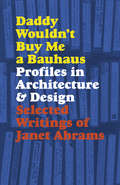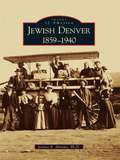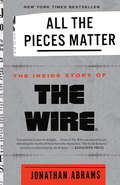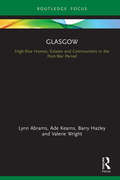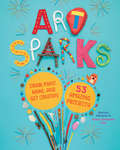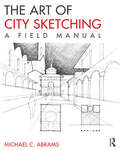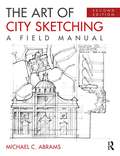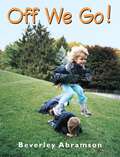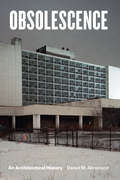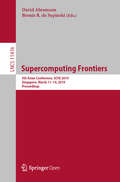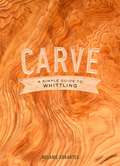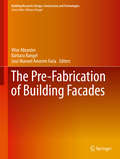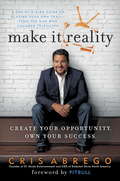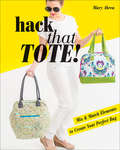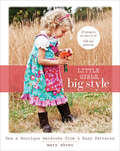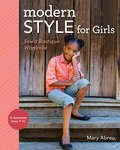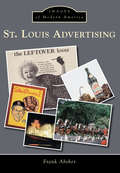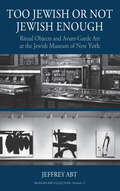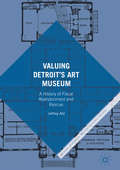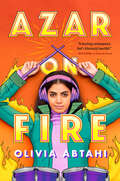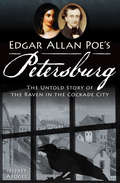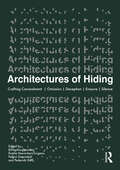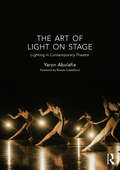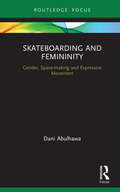- Table View
- List View
Daddy Wouldn't Buy Me a Bauhaus: Profiles in Architecture and Design
by Janet AbramsDaddy Wouldn't Buy Me a Bauhaus collects the unparalleled writings of legendary British wordsmith Janet Abrams for the first time. From pivotal figures in international modernism to the pioneers of digital medium, Abrams explored the ideas, theories, and emotions that fueled their work.The book's twenty-six profiles, written in Abrams's signature, personal, often hilarious style, include Reyner Banham, Berthold Lubetkin, Philip Johnson, Paul Rand, Phyllis Lambert, Frank Gehry, Rem Koolhaas, Muriel Cooper, April Greiman, and Michael Bloomberg. Many of the profiles are back in print for the first time, having originally appeared in Blueprint, I.D. magazine, the Independent, and in books and catalogs from the 1980s through the early 2000s. A foreword by Blueprint's founding editor, Deyan Sudjic, and new reflections by Abrams set the stage.
Jewish Denver: 1859-1940 (Images of America)
by Jeanne E. AbramsIn 1859, during the Pike's Peak gold rush, at least 12 Jews joined the great migration to Colorado in search of gold and a brighter future. The unpredictability of mining and a growing demand for supplies encouraged many of these Jewish settlers to establish small businesses in Denver and in towns and mining camps across the state. By the early 1870s, Jewish benevolent societies and a congregation were established. Denver's dry, mild climate attracted patients with tuberculosis, and two Jewish sanatoriums were opened in the city around the beginning of the 20th century. Many of the predominantly Eastern European Jews who came in search of better health made Denver their home, thus augmenting the early Jewish population significantly. Today Jewish life flourishes in Colorado, and Jewish citizens continue to play a vital role in its culture and development.
All the Pieces Matter: The Inside Story of The Wire®
by Jonathan Abrams<P>The definitive oral history of the iconic and beloved TV show The Wire, as told by the actors, writers, directors, and others involved in its creation. <P>Since its final episode aired in 2008, HBO's acclaimed crime drama The Wire has only become more popular and influential. The issues it tackled, from the failures of the drug war and criminal justice system to systemic bias in law enforcement and other social institutions, have become more urgent and central to the national conversation. <P>The show's actors, such as Idris Elba, Dominic West, and Michael B. Jordan, have gone on to become major stars. Its creators and writers, including David Simon and Richard Price, have developed dedicated cult followings of their own. Universities use the show to teach everything from film theory to criminal justice to sociology. Politicians and activists reference it when discussing policy. When critics compile lists of the Greatest TV Shows of All Time, The Wire routinely takes the top spot. It is arguably one of the great works of art America has produced in the 20th century. <P>But while there has been a great deal of critical analysis of the show and its themes, until now there has never been a definitive, behind-the-scenes take on how it came to be made. With unparalleled access to all the key actors and writers involved in its creation, Jonathan Abrams tells the astonishing, compelling, and complete account of The Wire, from its inception and creation through its end and powerful legacy. <P><b>A New York Times Bestseller</b>
Glasgow: High-Rise Homes, Estates and Communities in the Post-War Period (Built Environment City Studies)
by Lynn Abrams Ade Kearns Barry Hazley Valerie WrightIn the wake of an unparalleled housing crisis at the end of the Second World War, Glasgow Corporation rehoused the tens of thousands of private tenants who were living in overcrowded and unsanitary conditions in unimproved Victorian slums. Adopting the designs, the materials and the technologies of modernity they built into the sky, developing high-rise estates on vacant sites within the city and on its periphery. This book uniquely focuses on the people's experience of this modern approach to housing, drawing on oral histories and archival materials to reflect on the long-term narrative and significance of high-rise homes in the cityscape. It positions them as places of identity formation, intimacy and well-being. With discussions on interior design and consumption, gender roles, children, the elderly, privacy, isolation, social networks and nuisance, Glasgow examines the connections between architectural design, planning decisions and housing experience to offer some timely and prescient observations on the success and failure of this very modern housing solution at a moment when high flats are simultaneously denigrated in the social housing sector while being built afresh in the private sector. Glasgow is aimed at an academic readership, including postgraduate students, scholars and researchers. It will be of interest to social, cultural and urban historians particularly interested in the United Kingdom.
Art Sparks: Draw, Paint, Make, and Get Creative with 53 Amazing Projects!
by Marion Abrams Hilary Emerson LayEvery kid can be an artist with this book as their guide! Using basic art supplies — from paint, markers, paper, and glue to household finds like cardboard boxes and fabric scraps — children aged 6 and up learn that as long as they can imagine it, they can create it. Curated by two art educators with decades of experience, this rich collection of 53 arts and crafts activities offers up a ton of freeform fun, from Doodlemonsters and Painted Animal Rocks to Paper Bead Jewelry and Nature Weaving. Projects vary in difficulty so there’s something for a wide range of ages and abilities, and many can be completed in under an hour. Each project featured in the book has been kid-made (and kid-approved!), and colorful photos of the finished pieces will ignite a creative spark that inspires budding makers to express their imagination, humor, and individuality through art. This publication conforms to the EPUB Accessibility specification at WCAG 2.0 Level AA.
The Art of City Sketching: A Field Manual
by Michael AbramsThe Art of City Sketching: A Field Manual guides you through the laborious and sometimes complex process of sketching what you see in the built environment so that you can learn to draw what you imagine. Illustrated with hundreds of drawings by students and professionals of cityscapes around Europe and the United States, the book helps you develop your conceptual drawing skills so that you can communicate graphically to represent the built environment. Short exercises, projects, drawing tips, step-by-step demonstrations, and composition do's and don'ts make it easy for you to get out into the city and experiment in your own work. Author Michael Abrams uses his experience as a field sketching instructor, to show you that by drawing, you can discover, analyze, and comprehend the built environment.
The Art of City Sketching: A Field Manual
by Michael C. AbramsThe Art of City Sketching: A Field Manual guides readers through the process of freehand architectural sketching and explains orthographic, diagrammatic, three-dimensional, and perceptual-type drawings. The book presents hundreds of drawings of historic buildings and urban spaces, examples, and exercises, which help readers develop their drawing skills and employ sketching as an analytical tool. The book is divided into three parts, based on the reader’s skill level: beginner, intermediate, and advanced. As an architect and field sketching instructor, the author shows that through drawing the reader can discover, analyze, and comprehend the built environment. The new edition of The Art of City Sketching expands on the drawing techniques of the previous version by adding new drawing examples, exercises, and two new chapters—Chiaroscuro and Storyboard. New drawing tips, demonstrations, and composition "do’s and don’ts" will support readers when they illustrate their viewpoint of the city by using simple drawing tools. The lessons in this book will allow readers to mix method with imagination and sensibility.
Off We Go!
by Beverley AbramsonThe natural state of toddlers and young children is motion, and Beverley Abramson’s splendid photographs are an appreciation of the many ways in which we can move. Children spin and whirl, run, jump, and climb through the seasons in photographs that beg for discussion and storytelling.Whether it is flying a kite or kicking a ball, skipping on the grass or riding a tricycle, Beverley Abramson has captured kids experiencing the sheer pleasure of exploring the world through movement. Best of all, it is an invitation to get children to discover the fun of physical play.
Obsolescence
by Daniel M. AbramsonIn our architectural pursuits, we often seem to be in search of something newer, grander, or more efficient--and this phenomenon is not novel. In the spring of 1910 hundreds of workers labored day and night to demolish the Gillender Building in New York, once the loftiest office tower in the world, in order to make way for a taller skyscraper. The New York Times puzzled over those who would sacrifice the thirteen-year-old structure, "as ruthlessly as though it were some ancient shack." In New York alone, the Gillender joined the original Grand Central Terminal, the Plaza Hotel, the Western Union Building, and the Tower Building on the list of just one generation's razed metropolitan monuments. In the innovative and wide-ranging Obsolescence, Daniel M. Abramson investigates this notion of architectural expendability and the logic by which buildings lose their value and utility. The idea that the new necessarily outperforms and makes superfluous the old, Abramson argues, helps people come to terms with modernity and capitalism's fast-paced change. Obsolescence, then, gives an unsettling experience purpose and meaning. Belief in obsolescence, as Abramson shows, also profoundly affects architectural design. In the 1960s, many architects worldwide accepted the inevitability of obsolescence, experimenting with flexible, modular designs, from open-plan schools, offices, labs, and museums to vast megastructural frames and indeterminate building complexes. Some architects went so far as to embrace obsolescence's liberating promise to cast aside convention and habit, envisioning expendable short-life buildings that embodied human choice and freedom. Others, we learn, were horrified by the implications of this ephemerality and waste, and their resistance eventually set the stage for our turn to sustainability--the conservation rather than disposal of resources. Abramson's fascinating tour of our idea of obsolescence culminates in an assessment of recent manifestations of sustainability, from adaptive reuse and historic preservation to postmodernism and green design, which all struggle to comprehend and manage the changes that challenge us on all sides.
Supercomputing Frontiers: 5th Asian Conference, SCFA 2019, Singapore, March 11–14, 2019, Proceedings (Lecture Notes in Computer Science #11416)
by David Abramson Bronis R. de SupinskiThis open access book constitutes the refereed proceedings of the 5th Asian Supercomputing Conference, SCFA 2019, held in Singapore in March 2019. The 6 full papers presented in this book were carefully reviewed and selected from 33 submissions. They cover a range of topics including memory fault handling, linear algebra, image processing, heterogeneous computing, resource usage prediction, and data caching.
Carve: A Simple Guide to Whittling
by Melanie AbrantesWhittle a beautiful spoon, comb, pair of dice, and more with this fresh introduction to a folksy craft. Carve modernizes a mindful hobby that people have turned to for generations to help them slow down, relax, and connect with the outdoors. Choose from a dozen projects with bespoke details, all are designed to be useful at home or while camping. And because these objects are small, they require only a few hours and a tool or two to complete. You'll also learn how to choose the right knife and wood, helpful information on techniques and safety, and tips for refining, personalizing and maintaining your piece. Whether you're headed to the woods or just to the porch, this pocket-sized guide will have you carving your own unique designs in no time.From the Hardcover edition.
The Pre-Fabrication of Building Facades
by Vítor Abrantes Bárbara Rangel José Manuel Amorim FariaThis book compares two buildings with different technologies and distinct environment from the combined viewpoints of civil engineering and architecture. The first is the most recent building of Columbia University in New York, the Northwest Science Building, a project designed by Rafael Moneo and Dan Brodkin of Ove Arup. The second one is the Burgo Tower in Oporto, by Eduardo Souto Moura and Rui Furtado of AFA, a building that brings a new perspective to the use of prefabrication technologies with local traditional construction systems. With the detailed analyses of recognized researchers in civil engineering and architecture, this book is a reflection upon the problems and solutions in the design and construction process of a prefabricated building system. This volume, like those to follow, brings together, building research and building design practice to enhance the knowledge of complementarity areas involved in construction, engineering and architecture. This is the first book in a new series "Building Research: Design, Construction and Technologies" which aims to bridge scientific research and professional practice to understand the Building Design problems. In each edition, one or two case studies (recognized buildings in the international design panorama) are analyzed with their authors to assess the design process and the construction development. To understand the problems involved, researchers, engineers and architects, are asked to contribute to this ana lysis with essays on building research issues, as building technology, construction management, acoustics, maintenance or prefabrication.
Make It Reality: Create Your Opportunity, Own Your Success
by Cris Abrego PitbullThe creator and producer of several mega-hit television series, including The Surreal Life, Flavor of Love, Rock of Love, and Charm School, shares his incredible journey of making it to the top--and how you can too. "No one paves the road for you. You have to create your own path. If you believe in your dreams, embrace what makes you different, and bet on yourself, the destination will be greater than you ever imagined."--Cris Abrego From carrying camera gear on the sets of MTV's Road Rules, to pioneering the celebreality genre by creating such breakout hits as The Surreal Life and The Flavor of Love, and now as one of today's most prominent figures in the television industry--Cris Abrego's career has been nothing short of extraordinary. As a young boy growing up in L.A., Abrego spent his formative years glued to his family's TV set, forging his dream of one day working in television. With unrelenting drive, he overcame countless obstacles to build his own reality TV production company in his garage, which, by his mid-thirties, he sold to one of the world's largest television production companies, before being tapped as their co-CEO. In Make It Reality, Abrego provides practical and motivating lessons collected from almost twenty years on the frontlines of television, including: how to visualize and your goals and work tirelessly to attain them; when to take risks and push boundaries; and how to continually raise the bar for yourself and realize there are no limits on what can be achieved. Success isn't about your pedigree or your connections: it's about vision, leadership, and courage. Abrego's story is unforgettable, full of heart, and inspiring to anyone seeking to transcend all obstacles and achieve true success.Foreword by PitbullFrom the Hardcover edition.
Hack That Tote!: Mix & Match Elements to Create Your Perfect Bag
by Mary Abreu“A terrific book for the beginner bag maker and anyone looking for fairly quick and easy bag projects” —from a wine-bottle bag to a zip-top purse (Homespun).One pattern . . . infinite looks! With simple tweaks, you can reinvent the basic tote 11 ways, sewing useful projects like a backpack, messenger bag, laundry duffle, and stylish cross-body purse. Create your perfect carryall by adding pockets, leather handles, fabric straps and tabs, O-rings, snap hooks, purse frames, and more for endless variety. A fabric and interfacing guide helps beginners and more experienced sewists choose the right materials every time. Just measure, mark, and cut—no printed patterns needed!Alter a basic tote 11 ways! Switch up the size, shape, pockets, straps, drawstrings, zippers, and hardware to create bags for many usesExpert tips on choosing the right fabric and interfacing for sturdy bags that look amazingEasy, dimensional cutting instructions for fast, professional results“In this beginner-friendly guide, Abreu (Modern Style for Girls) takes a basic square tote pattern and adjusts it in a variety of ways to create a wardrobe of attractive bags in different shapes and styles, from casual and functional to structured and sophisticated.” —Library Journal“Join Abreu as she takes a basic tote bag pattern and transforms it 11 different ways by varying the shape and size of her bags, as well as the detailing such as pockets, handles, and, of course, color and fabric combinations. By following Mary’s tips, you'll create professional-looking bags for yourself and friends.” —Quilter’s Companion
Little Girls, Big Style: Sew a Boutique Wardrobe from 4 Easy Patterns
by Mary AbreuLearn to create unique, well-fitted clothing for your little ones with this illustrated guide featuring 4 easy patterns and 23 projects in sizes 2-6.In Little Girls, Big Style, author and professional seamstress Mary Abreu offers a comprehensive guide to making beautiful clothes that fit your daughter—and your budget—perfectly. Every day can be dress-up day when you mix and match the four basic patterns featured in this book to create hundreds of adorable outfits. Mary makes this guide beginner-friendly with complete instructions on all the basics-finishing seams, gathering, topstitching, hemming, shirring, and more. She also offers tips on how to make each item your own with your favorite fabrics and embellishments. Everything you need to learn is here, from the basic sewing to the stylish finishing.
Modern Style for Girls: Sew a Boutique Wardrobe
by Mary Abreu“Designed [for] the tastes of the tween . . . from a simple and stylish vintage-inspired A-line collared dress to a gorgeous paneled skirt.” —Love SewingBestselling author Mary Abreu is back with a book that will shut down the dreaded words, “I have nothing to wear!” from young girls. Starting with three basic pieces—a top/dress, skirt, and pants—you’ll learn how to modify simple patterns and rectangles to make twelve classic garments: four tops/dresses, four shorts/pants, and four skirts. Technique instructions teach you how to gather, create waistband casings, and insert zippers. Advice on choosing fabrics and adding embellishments is also included. With this handy guide, you can help your girls develop a style all their own.Add collars, change armholes, and add ruffles to basic garments to create updated takes on existing piecesClear techniques will guide you on how to finish seam allowances, insert zippers, hem, and add unique embellishmentsHelp your girls create an entirely new wardrobe of classic pieces to mix and match in any way they want “The focus here is on sizes seven to 12—an age in which girls want clothes that don’t look babyish but are still appropriate for play. Designs include tops, dresses, pants, shorts, and skirts, and the style is charmingly retro—think pedal pushers and Peter Pan collars but in contemporary fabrics . . . Most pattern books for children’s clothing concentrate on smaller-sized clothing for babies, toddlers, and preschoolers, so the focus on school-aged children’s clothing makes this a nice addition for sewing collections.” —Library Journal
John Ruskin: The Passionate Moralist
by Joan AbseJoan Abse treats Ruskin with deep and proper respect from start to finish; and she writes best of all on his ideas about art and artists.
St. Louis Advertising
by Frank AbsherMention "advertising," and just about everyone thinks of New York's Madison Avenue, long the center of the nation's advertising universe. The reality is that advertising is everywhere and has been almost since the inception of the nation. In St. Louis, for example, two early advertising agencies became major players on the national scene, creating advertising for multinational corporations. Browsing through this collection of old advertisements gives readers a chance to follow the development of the nation's business community over the past 200 years and see what was important in the daily lives of Americans, as well as what the nation's commercial interests wanted them to believe was important.
Too Jewish or Not Jewish Enough: Ritual Objects and Avant-Garde Art at the Jewish Museum of New York (Museums and Collections #17)
by Jeffrey AbtDisplays of Jewish ritual objects in public, non-Jewish settings by Jews are a comparatively recent phenomenon. So too is the establishment of Jewish museums. This volume explores the origins of the Jewish Museum of New York and its evolution from collecting and displaying Jewish ritual objects, to Jewish art, to exhibiting avant-garde art devoid of Jewish content, created by non-Jews. Established within a rabbinic seminary, the museum’s formation and development reflect changes in Jewish society over the twentieth century as it grappled with choices between religion and secularism, particularism and universalism, and ethnic pride and assimilation.
Valuing Detroit’s Art Museum
by Jeffrey AbtThis book explores the perilous situation that faced the Detroit Institute of Arts during the city's bankruptcy, when creditors considered it a "nonessential asset" that might be sold to settle Detroit's debts. It presents the history of the museum in the context of the social, economic, and political development of Detroit, giving a history of the city as well as of the institution, and providing a model of contextual institutional history. Abt describes how the Detroit Institute of Arts became the fifth largest art museum in America, from its founding as a private non-profit corporation in 1885 to its transformation into a municipal department in 1919, through the subsequent decades of extraordinary collections and facilities growth coupled with the repeated setbacks of government funding cuts during economic downturns. Detroit's 2013 bankruptcy underscored the nearly 130 years of fiscal missteps and false assumptions that rendered the museum particularly vulnerable to the monetary power of a global art investment community eager to capitalize on the city's failures and its creditors' demands. This is a remarkable and important contribution to many fields, including non-profit management and economics, cultural policy, museum and urban history, and the histories of both the Detroit Institute of Arts and the city of Detroit itself. Despite the museum's unique history, its story offers valuable lessons for anyone concerned about the future of art museums in the United States and abroad.
Azar on Fire
by Olivia AbtahiFinding her voice takes on a whole new meaning when fourteen-year-old Azar Rossi sets out to win her local Battle of the Bands contest in this heartfelt and hilarious contemporary YA.Fourteen-year-old Azar Rossi&’s first year of high school has mostly been silent, and intentionally so. After a bad case of colic as a baby, Azar&’s vocal folds are shredded—full of nodules that give her a rasp the envy of a chain-smoking bullfrog. Her classmates might just think she&’s quiet, but Azar is saving her voice for when it really counts and talking to her classmates is not medically advisable or even high on her list.When she hears about a local Battle of the Bands contest, it&’s something she can&’t resist. Azar loves music, loves songwriting, but with her vocal folds the way they are, there's no way she can sing her songs on stage. Then she hears lacrosse hottie, Ebenezer Lloyd Hollins the Fifth, aka Eben, singing from the locker room. She&’s transfixed. He's just the person she needs. His voice + her lyrics = Battle of the Bands magic. But getting a band together means Azar has a lot of talking to do and new friends to make. For the chance to stand on stage with Eben it might all just be worth it.
Edgar Allan Poe's Petersburg: The Untold Story of the Raven in the Cockade City
by Jeffrey AbugelVisit the Virginia city where the great author brought his thirteen-year-old bride for a honeymoon. Antebellum Petersburg was a melting pot of French, Haitian, Scotch-Irish, and free black populations. It was in this eclectic city that the master of the macabre, Edgar Allan Poe, chose to take his new wife, thirteen-year-old first cousin Virginia Clemm, on their honeymoon in 1836. This book traces the steps of the controversial couple through imaginative scenes of historic Petersburg. From Poe&’s own mother performing in the local venues to the poet&’s lasting friendship with Petersburg native and publisher Hiram Haines, it reveals an overlooked moment in the young life of this literary giant. Includes photos
Architectures of Hiding: Crafting Concealment | Omission | Deception | Erasure | Silence
by Rana Abughannam Émélie Desrochers-Turgeon Pallavi Swaranjali Federica GoffiArchitecture manifests as a space of concealment and unconcealment, lethe and alêtheia, enclosure and disclosure, where its making and agency are both hidden and revealed. With an urgency to amplify narratives that are overlooked, silenced and unacknowledged in and by architectural spaces, histories and theories, this book contends the need for a critical study of hiding in the context of architectural processes. It urges the understanding of inherent opportunities, power structures and covert strategies, whether socio-cultural, geo-political, environmental or economic, as they are related to their hidescapes – the constructed landscapes of our built environments participating in the architectures of hiding. Looking at and beyond the intentions and agency that architects possess, architectural spaces lend themselves as apparatuses for various forms of hiding and un(hiding). The examples explored in this book and the creative works presented in the interviews enclosed in the interludes of this publication cover a broad range of geographic and cultural contexts, discursively disclosing hidden aspects of architectural meaning. The book investigates the imaginative intrigue of concealing and revealing in design processes, along with moral responsibilities and ethical dilemmas inherent in crafting concealment through the making and reception of architecture.
The Art of Light on Stage: Lighting in Contemporary Theatre
by Yaron AbulafiaThe Art of Light on Stage is the first history of theatre lighting design to bring the story right up to date. In this extraordinary volume, award-winning designer Yaron Abulafia explores the poetics of light, charting the evolution of lighting design against the background of contemporary performance. The book looks at the material and the conceptual; the technological and the transcendental. Never before has theatre design been so vividly and excitingly illuminated. ? The book examines the evolution of lighting design in contemporary theatre through an exploration of two fundamental issues: ? 1.?????? What gave rise to the new directions in lighting design in contemporary theatre? 2.?????? How can these new directions be viewed within the context of lighting design history? ? The study then focuses on the phenomenological and semiotic aspects of the medium for light – the role of light as a performer, as the medium of visual perception and as a stimulus for imaginative representations – in selected contemporary theatre productions by Robert Wilson, Romeo Castellucci, Heiner Goebbels, Jossi Wieler and David Zinder. ? This ground-breaking book will be required reading for anyone concerned with the future of performance.
Skateboarding and Femininity: Gender, Space-making and Expressive Movement (Routledge Advances in Theatre & Performance Studies)
by Dani AbulhawaSkateboarding and Femininity explores and highlights the value of femininity both within skateboarding and wider culture. This book examines skateboarding’s relationship to gender politics through a consideration of the personal politics connected to individual skateboarders, the social-spatial arenas in which skateboarding takes place, and by understanding the performance of tricks and symbolic movements as part of gender-based power dynamics. Dani Abulhawa anaylses the discursive frameworks connected to skateboarding philanthropic projects and how these operate through gendered tropes. Through the author’s work with skateboarding charity SkatePal, this book offers an alternative way of recognising the value of skateboarding philanthropy projects, proposing a move toward a more open and explorative somatic practice perspective.
